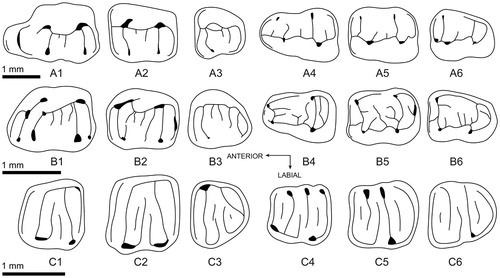Figures & data
FIGURE 1. Location of the Caijiachong mammalian fossil sites in China. Caecocricetodon yani gen. et sp. nov. fossils were discovered from the highest fossiliferous layer (marked with black arrowhead).
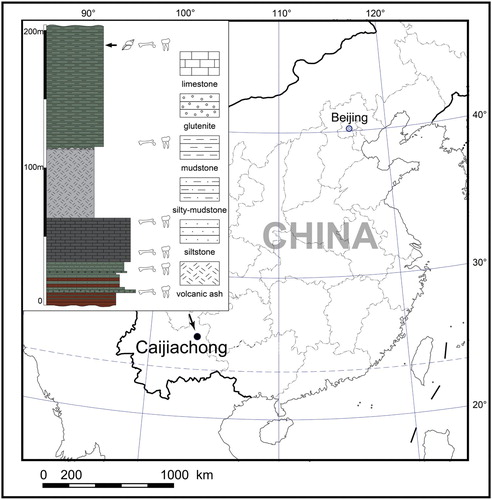
FIGURE 2. Upper and lower teeth of Caecocricetodon yani, gen. et sp. nov.: A, holotype, V 26103, right M1; B, V 26104.1, left M1; C, V 26104.2, right M1; D, V 26104.64, right M2; E, V 26104.65, left M2; F, V 26104.66, left M2; G, V 26104.128, left M3; H, V 26104.129, right M3; I, V 26104.130, right M3; J, V 26104.164, left m1; K, V 26104.165, right m1; L, V 26104.166, left m1; M, V 26104.222, left m2; N, V 26104.223, right m2; O, V 26104.224, left m2; P, V 26104.281, left m3; Q, V 26104.282, left m3; R, V 26104.283, left m3; B, E, F, G, K, N are reversed.
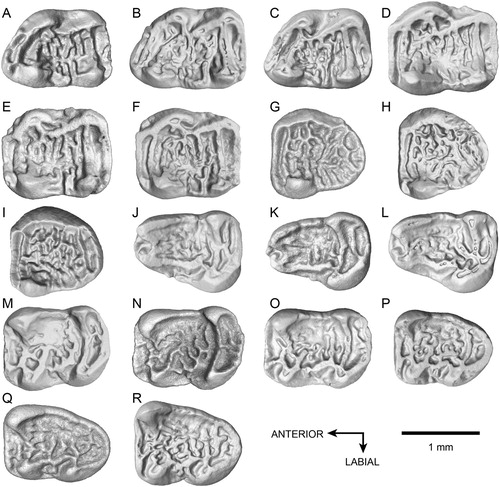
FIGURE 3. Colorized pattern for upper teeth of Caecocricetodon yani, gen. et sp. nov. A1, V 26104.44, right M1; A2, V 26104.51, left M1; A3, V 26104.12, right M1; A4, V 26104.50, left M1; A5, V 26104.45, right M1; A6, V 26104.53, left M1; A7, V 26104.13, left M1; A8, V 26104.10, left M1; A9, V 26104.47, left M1; A10, V 26104.54, right M1; A11, V 26104.19, left M1; A12, V 26104.33, right M1; A13, V 26104.48, right M1; A14, V 26104.8, right M1; A15, V 26104.16, right M1; A16, V 26104.39, left M1; B1, V 26104.74, left M2; B2, V 26104.69, left M2; B3, V 26104.77, left M2; B4, V 26104.81, right M2; B5, V 26104.75, left M2; B6, V 26164.70, left M2; B7, V 26104.79, right M2; B8, V 26104.83, left M2; B9, V 26104.85, right M2; C1, V 26104.139, right M3; C2, V 26104.141, right M3; C3, V 26104.142, right M3; C4, V 26104.144, left M3; C5, V 26104.145, right M3; C6, V 26104.134, right M3; A2, A4, A6, A7, A8, A9, A11, A16, B1, B2, B3, B5, B6, B8, and C4 are reversed. Color reference: blue, main lophs including anteroloph, mesial and distal protolophules, metalophule and posteroloph; green, red, orange, sky blue, purple and brown, mesolophs; yellow, labial cingulum.
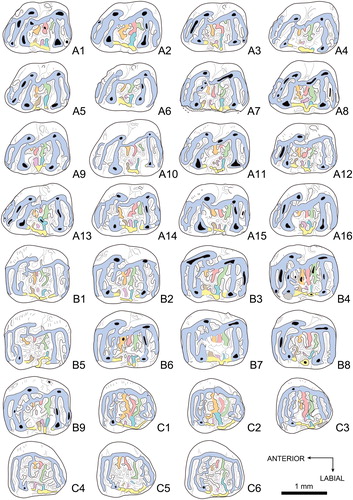
FIGURE 4. Colorized pattern for lower teeth of Caecocricetodon yani, gen.et sp. nov. A1, V 26104.169, right m1; A2, V 26104.170, left m1; A3, V 26104.172, right m1; A4, V 26104.174, right m1; A5, V 26104.175, left m1; B1, V 26104.226, right m2; B2, V 26104.230, right m2; B3, V 26104.233, left m2; B4, V 26104.236, right m2; B5, V 26104.242, left m2; B6, V 26104.246, left m2; C1, V 26104.285, right m3; C2, V 26104.288, left m3; C3, V 26104.297, left m3; C4, V 26104.301, left m3; A1, A3, A4, B1, B2, B4, and C1 are reversed. Color reference: blue, including lingual cingulid, ectolophid, hypolophulid and posterolophid; green, distal arm of metaconid; purple, distal arm of protoconid; orange, anterolophid; yellow and red, mesolophids.
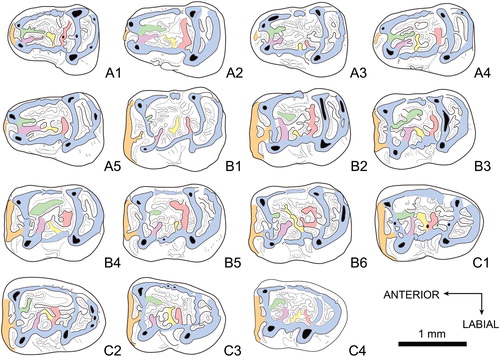
TABLE 1. Molar measurements of Caecocricetodon yani, sp. nov. (in mm). Abbreviations: CV, coefficient of variation; Max, maximal value; Min, minimal value; N, number of specimens; StD, standard deviation.
FIGURE 5. Result of the phylogenetic analysis, with the strict consensus tree of six most parsimonious trees. Scale bar equals 8 character changes.

FIGURE 6. Comparison of molars among the Early Oligocene rodents. Eucricetodon caducus Shevyreva, Citation1967 (Cricetidae): A1–A3, M1–M3, A4–A6, m1–m3; Caecocricetodon yani, gen. et sp. nov. (Cricetidae): B1–B3, M1–M3, B4–B6, m1–m3; Microdyromys misonnei Vianey-Liaud, Citation1994 (Gliridae): C1–C3, M1–M3, C4–C6, m1–m3.
